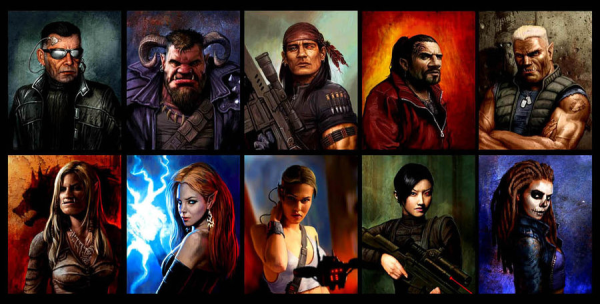In Part I of this series, I laid out my plan to play through a series of RPG systems – one a week – over the summer. On top of that, I wrote about my gaming groups’ desire to maintain a single set of characters and therefore a cohesive story for the duration of the campaign.
This week (well, two weeks) we played Shadowrun. The group as a whole was pretty excited, as they’d heard good things about the game. It was new to everyone, myself included. I started the story with the new Shadowrun characters passing their Gamma World characters in a huge teleportation transportation hub, in keeping with our decision to change characters with RPG systems and hang the one-shot stories together more loosely.
Shadowrun is only the second new RPG that I’ve run this summer, even though it’s the fourth system we’re using. I am very familiar with D&D 4e and Gamma World (our first and third weeks), though our second RPG – Microscope – was also new to me. Of course, Microscope is a GM-less game, so it’s safe to say that Shadowrun was my first real trial in learning and running a brand new game in the span of a week.
So, a quick lowdown on mechanics for those of you unfamiliar. Shadowrun uses dice pools of d6’s to manage action resolution. Your character has a number “rating” in each attribute (like strength or intelligence) as well as a number rating in a handful of skills (like hacking or small arms). And I will say there are a lot of skills in this game. When you try to do something, the GM will ask for a roll like this – “That’s intelligence plus hacking” – so you add together the number you have for intelligence and the number you have for hacking, then roll that many d6’s. Let’s say you have a 6 in intelligence and a 4 in hacking – you roll 10d6. Yup, rolling a fistful of d6’s is pretty common. Out of all those d6’s you just rolled, any 5’s or 6’s are successes (or “hits”), and you’re trying to meet a “threshold” of “hits,” which is basically the DC of the action.
Combat is a bit more complicated, and also a bit more complicated than D&D combat, but it still uses the “roll a fistful of d6’s and count up your 5’s and 6’s” mechanic.
Our Shadowrun session ran two weeks – the first week we ran through the Quickstart scenario, which saw the characters in a Stuffer Shack brawl, and the second week we used the adventure Ping Time, which I found for free online. It was easy to modify the quickstart scenario to lead into Ping Time – I simply changed the “target” that the PCs rescue in the Quickstart into the fixer that employs them in Ping Time. Easy peasy.
The Quickstart was great to get a feel for the game – both thematically and mechanically. The majority of it is combat, which is essential because combat is the most complicated part of the game (as far as I could tell). The players got to go through several rounds of opposed rolls and counting net successes and comparing armor to damage, and… well, you get the picture. It gave them a handle on the game.
Ping Time kind of flipped that on them because there’s only one combat, and it occurs at the very end of the adventure. There is the possibility of combat at other points in the adventure, but it is assumed that the characters use other means to achieve their ends most of the time.
Overall, we really liked Shadowrun. As a matter of fact, I liked it enough to preorder the 5th edition rules which coincidentally went up for sale around the time we played. It’s possible we’ll be playing at least a few sessions of it next summer. Even if we don’t, I’m very intrigued to read about the myriad skills present in this system.
What I Learned
Quickstart rules are fine if all you’re running is the quickstart scenario, but if you’re going to dip into other free adventures (for any system), you’re probably going to want the actual rules. In Ping Time, I was able to muddle through some things, but I was completely unable to improvise anything on the spot. And I said so to the players.
On the other hand, Quickstart rules are awesome if you’re playing a bunch of new RPGs serially. They’re the single most important resource for a group looking to learn a new system. Everything is laid out as if you’re a beginner (because you are), and what is presented is only what you need. It’s also whatever the designers think you need to get a good feel for the system. And that’s pretty important.
I also learned to not be afraid of Theatre of the Mind. While I have had a foray or two into mapless combat in the past, the majority of my RPG experience has used maps for combat. But we were able to slide pretty easily into Shadowrun’s assumption that you don’t need a piece of wet erase vinyl to kill stuff. And that’s good, because we’re headed into Leverage and Dread in a few weeks, and both of those systems rely on TotM alone. But first, we’re taking an unscheduled detour into Pathfinder next week. And I’m not the DM!


I like the teleporter link. Nice touch and nice compromise.
Thanks! Finding ways to bridge the systems was challenging at first, but then I just worried less about it.